
|
According to DIN EN 752, an inverted siphon is a section of a depressed sewer or gravity sewer, which operates under pressure as it is installed lower than the upstream, and the downstream sections of the pipe. It is a system used to pass under obstacles such as streams or structures [EN752:2008]. When inverted siphons discharge wastewater and/or stormwater, they usually cannot be operated entirely free of agglomerations and deposits [Loren2003]. The … |
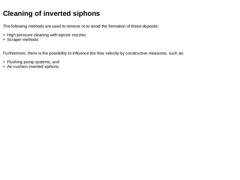
|
The following methods are used to remove or to avoid the formation of these deposits: -
High pressure cleaning with ejector nozzles
-
Scraper methods
Furthermore, there is the possibility to influence the flow velocity by constructive measures, such as: -
Flushing pump systems, and
-
Air-cushion inverted siphons.
|
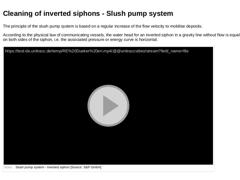
|
The principle of the slush pump system is based on a regular increase of the flow velocity to mobilise deposits. According to the physical law of communicating vessels, the water head for an inverted siphon in a gravity line without flow is equal on both sides of the siphon, i.e. the associated pressure or energy curve is horizontal. (Video: Slush pump system - Inverted siphon) |
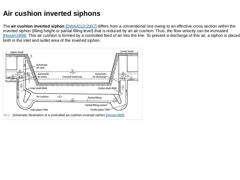
|
The air cushion inverted siphon [DWAA112:2007] differs from a conventional one owing to an effective cross section within the inverted siphon (filling height or partial filling level) that is reduced by an air cushion. Thus, the flow velocity can be increased [Hosan1998]. This air cushion is formed by a controlled feed of air into the line. To prevent a discharge of this air, a siphon is placed both in the inlet and outlet area of the inverted siphon. |

|
Currently, high pressure cleaning is the most commonly used method to clean sewers. According to a survey by Stein in 2000, the use of high pressure cleaning in North Rhine-Westfalia (NRW), Germany, amounted to more than 95% of overall cleaning measures [SteinD00a]. Throughout Germany, this method was used in about 90% of all cases [Geib2002]. Hence the use of other cleaning methods in Germany is not more than 10%.
|
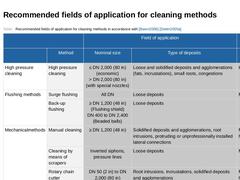
|
(Table: Recommended fields of application for cleaning methods in accordance with [Baren2006][Dettm2005a]) |
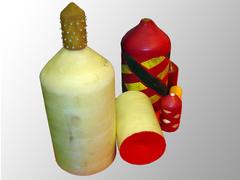
|
Special conditions apply to the cleaning of pressure pipes. This module is therefore explicitly dedicated to the procedures and methods used for cleaning this type of pipe. After completing this module, you will have knowledge of: - procedures for cleaning pressure pipelines and
- procedural principles.
|
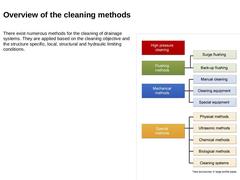
|
There exist numerous methods for the cleaning of drainage systems. They are applied based on the cleaning objective and the structure specific, local, structural and hydraulic limiting conditions.
(Image: Overview of the drain and sewer cleaning methods as per [Führb1980]) |

|
Selection of cleaning measures must be in accordance with [DIN EN 14654-1] and should also take into account the technical feasibility and economic viability, along with the following boundary conditions: - Type, quantity and composition of the deposits and obstacles
- Access to the location to be cleaned
- Road type and traffic situation
- Depth of cover
- Cross section and dimensions
- Change of cross section or displacement
- Material
- Structural condition
- Volumetric …
|
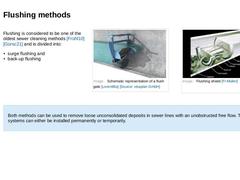
|
Flushing is considered to be one of the oldest sewer cleaning methods [Frühl10] [Gürsc21] and is divided into: -
surge flushing and
-
back-up flushing
(Image: Schematic representation of a flush gate) Both methods can be used to remove loose unconsolidated deposits in sewer lines with an unobstructed free flow. The flushing systems can either be installed permanently or temporarily. |
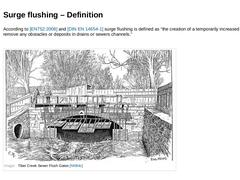
|
According to [EN752:2008] and [DIN EN 14654-1] surge flushing is defined as “the creation of a temporarily increased discharge to remove any obstacles or deposits in drains or sewers channels.”
(Image: Tiber Creek Sewer Flush Gates) |
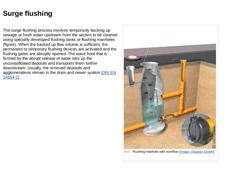
|
The surge flushing process involves temporarily backing up sewage or fresh water upstream from the section to be cleaned using specially developed flushing tanks or flushing manholes (figure). When the backed up flow volume is sufficient, the permanent or temporary flushing devices are activated and the flushing gates are abruptly opened. The wave front that is formed by the abrupt release of water stirs up the unconsolidated deposits and transports … |
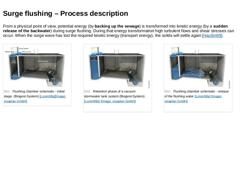
|
From a physical point of view, potential energy (by backing up the sewage) is transformed into kinetic energy (by a sudden release of the backwater) during surge flushing. During that energy transformation high turbulent flows and shear stresses can occur. When the surge wave has lost the required kinetic energy (transport energy), the solids will settle again [Haußm99]. (Image: Flushing chamber schematic - initial stage (Biogest-System)) |
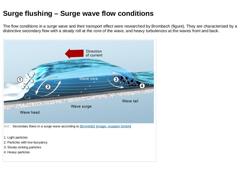
|
The flow conditions in a surge wave and their transport effect were researched by Brombach (figure). They are characterised by a distinctive secondary flow with a steady roll at the core of the wave, and heavy turbulences at the waves front and back. (Image: Secondary flows in a surge wave according to [Brombach]) |
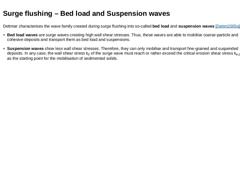
|
Dettmar characterises the wave family created during surge flushing into so-called bed load and suspension waves [Dettm2005a]. -
Bed load waves are surge waves creating high wall shear stresses. Thus, these waves are able to mobilise coarse-particle and cohesive deposits and transport them as bed load and suspensions.
-
Suspension waves show less wall shear stresses. Therefore, they can only mobilise and transport fine-grained and suspended deposits. …
|
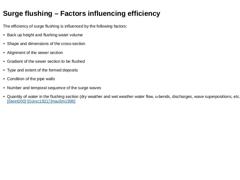
|
The efficiency of surge flushing is influenced by the following factors: -
Back up height and flushing water volume
-
Shape and dimensions of the cross-section
-
Alignment of the sewer section
-
Gradient of the sewer section to be flushed
-
Type and extent of the formed deposits
-
Condition of the pipe walls
-
Number and temporal sequence of the surge waves
-
Quantity of water in the flushing section (dry weather and wet weather water flow, u-bends, discharges, …
|
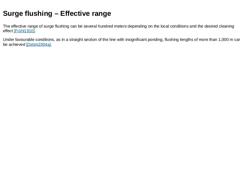
|
The effective range of surge flushing can be several hundred meters depending on the local conditions and the desired cleaning effect [Frühl1910]. Under favourable conditions, as in a straight section of the line with insignificant ponding, flushing lengths of more than 1,000 m can be achieved [Dettm2004a].
|
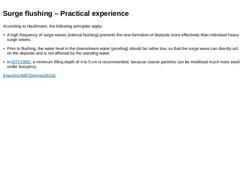
|
According to Haußmann, the following principles apply: -
A high frequency of surge waves (interval flushing) prevents the new formation of deposits more effectively than individual heavy surge waves.
-
Prior to flushing, the water level in the downstream water (ponding) should be rather low, so that the surge wave can directly act on the deposits and is not affected by the standing water.
-
In [ATV1995], a minimum filling depth of 4 to 5 cm is recommended, …
|

|
Currently, there are several different surge flushing devices used for surge flushing of drains and sewers as well as local drainage structures. According to [Dettm2004a], these devices are categorised into the following four groups based on their structure, technique, and equipment: -
Wastewater volume activated flushing system,
-
Flushing using a tipping bucket,
-
Flushing using a flushing chamber, and
-
Surge manhole flushing system.
|
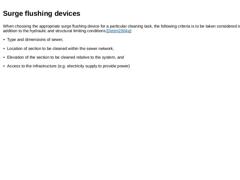
|
When choosing the appropriate surge flushing device for a particular cleaning task, the following criteria is to be taken considered in addition to the hydraulic and structural limiting conditions [Dettm2004a]: -
Type and dimensions of sewer,
-
Location of section to be cleaned within the sewer network,
-
Elevation of the section to be cleaned relative to the system, and
-
Access to the infrastructure (e.g. electricity supply to provide power)
|
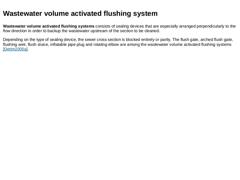
|
Wastewater volume activated flushing systems consists of sealing devices that are especially arranged perpendicularly to the flow direction in order to backup the wastewater upstream of the section to be cleaned. Depending on the type of sealing device, the sewer cross section is blocked entirely or partly. The flush gate, arched flush gate, flushing weir, flush sluice, inflatable pipe plug and rotating elbow are among the wastewater volume activated … |
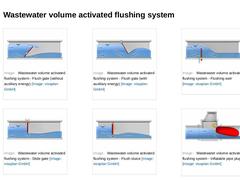
|
(Image: Wastewater volume activated flushing system - Flush gate (without auxiliary energy)) (Image: Wastewater volume activated flushing system - Flush gate (with auxiliary energy)) (Image: Wastewater volume activated flushing system - Flushing weir) (Image: Wastewater volume activated flushing system - Slide gate) (Image: Wastewater volume activated flushing system - Flush sluice) (Image: Wastewater volume activated flushing system - Inflatable pipe … |
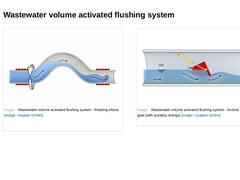
|
(Image: Wastewater volume activated flushing system - Rotating elbow) (Image: Wastewater volume activated flushing system - Arched flush gate (with auxiliary energy)) |
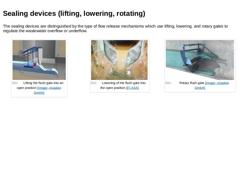
|
The sealing devices are distinguished by the type of flow release mechanisms which use lifting, lowering, and rotary gates to regulate the wastewater overflow or underflow. (Image: Lifting the flush gate into an open position) (Image: Lowering of the flush gate into the open position) (Image: Rotary flush gate) |
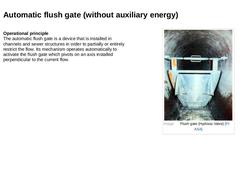
|
Operational principle
The automatic flush gate is a device that is installed in channels and sewer structures in order to partially or entirely restrict the flow. Its mechanism operates automatically to activate the flush gate which pivots on an axis installed perpendicular to the current flow. (Image: Flush gate (Hydrass Valve)) |